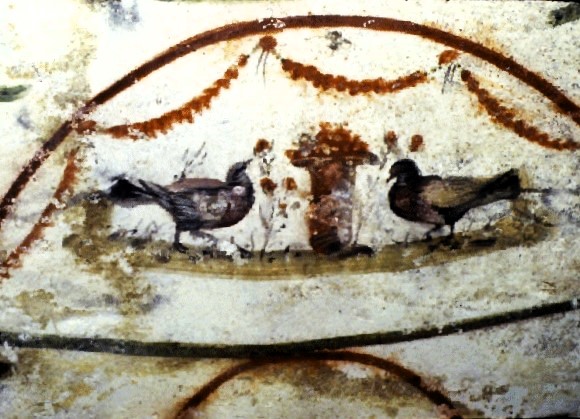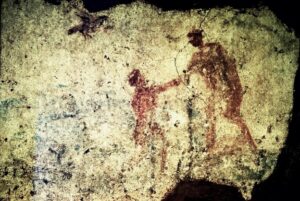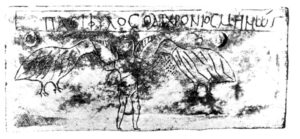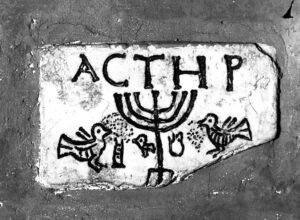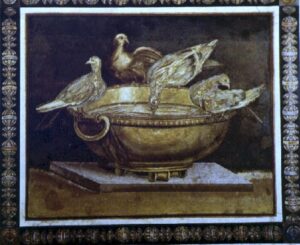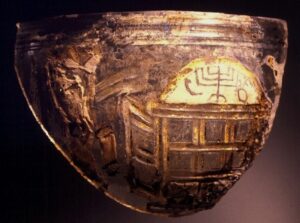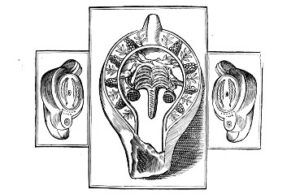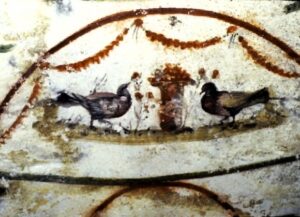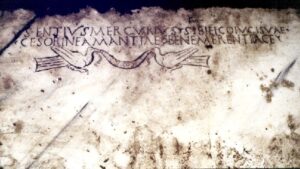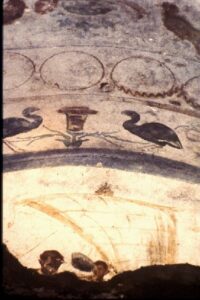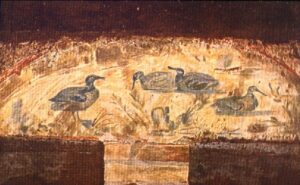Fauna: Birds. Excerpt from: Estelle Shohet Brettman, Vaults of Memory: The Roman Jewish Catacombs and their Context in the Ancient Mediterranean World, with Amy K. Hirschfeld, Florence Wolsky, & Jessica Dello Russo. Boston: International Catacomb Society, 1991-2017 (rev. 2024).
Ancient writers on natural history attributed certain qualities and traits of behavior to fish, birds and animals, based on popular traditions, folklore, and pseudo-scientific "observations." Philosophers and moralists held them up as examples, and these creatures became symbols for the vices and virtues with which they were endowed. Because their attributes were so well known and widely accepted, like flora, their presence in art served as a kind of shorthand for abstract ideas. Thus in the imagery of the catacombs, a few familiar motifs could express complex theological ideas, and the humblest worshipper, even though illiterate, could be reminded of scriptural teachings about God's grace toward man and man's duty to God, of sin, redemption, and man's hope for eternal life in the abode of the blessed.
I. The Dove
Like the fish, the dove passed into catacomb art as a symbol of the soul, reflecting earlier concepts of the winged soul. In Egyptian thought as mentioned above, the memorable essence of the deceased the power or personality often physically took on the form of a bird with a human head. As time went on the image evolved in other, cultures into an even more anthropomorphic appearance until it retained only the wings.
The more graphic conceptions of the soul (like Gen. 35:18: "And it came to pass, as her soul was in departing…" referring to Rachel's death) were perhaps influenced by the winged-soul or soul-bird imagery of Egyptian and Greek neighbors which included such Egyptian forms as the Ba, the Ka, or in Greek representations the psyche (often symbolized by such winged creatures as butterflies and birds) animating or vital force which was analogous to the Roman animus and Hebrew nefesh, the Greek immaterial phantom image or eidolon, and the Roman manes.[1]
Fig. 1. "The Ba living before or returning to Osiris. I in you(?).” End of Hagia Triada sarcophagus from the Minoan Era in Crete, with strange "supernatural bird" according to Marinatos, perhaps associated with the deceased, returning to two goddesses although, generally, birds seem to be "familiars" of the female deities in the mother goddess' oriented Minoan rites.[2] These divinities appear to play the role of psychopomps with the traditional assistance of winged quadrupeds (here griffins) appearing often as guardians in Crete-Mycenaean as well as in other 2nd millennial Mediterranean fantastic animal lore drawing their chariot.
John the Baptist likened the descent of the Spirit upon Christ at his baptism to the alighting of a bird, and thus the dove with outstretched wings became the symbol of the Holy Spirit: "And Jesus when he was baptized, went up straightway out of the water: and, lo, the heavens were opened unto him, and he saw the Spirit of God descending like a dove, and lighting upon him" (Matthew 3:16). This passage evokes the words of the Biblical prophet: "The Spirit of the Lord God is upon me; because the Lord hath anointed me to preach good tidings unto the meek… (Isa. 61:1) and "… the Spirit of God moved upon the waters" (Gen. 1:2). Portending "the day of the Lord… "the Lord will pour out his spirit upon all flesh as quoted from Joel (2:28, 31) by Peter in Acts 2:17, recalling: "I will pour my spirit upon thy seed, and my blessing upon thy offspring" (Is.44:3) and evoking I Cor. 12-13 and Acts 15:8-9 in which Paul indicates mankind's hope "because God's love has been poured into our hearts through the Holy Spirit…”[3]
Perhaps because of its association with divinity, the dove also became a metaphor for peace and purity. Thus according to Mosaic law, the dove was a suitable sacrifice for atonement or purification, and, because doves were thought to be ever faithful to a single mate, they became symbols of purity and chastity. The psalmist compared Israel to the turtledove: "O deliver not the soul of thy turtledove unto the multitude of the wicked" (Ps. 74:19), perhaps hinting at the sacrificial turtledove (Lev. 15:29, Num. 6:10), and yearning for the return of the scattered Israelites returning in that glorious time when they will be redeemed by the Lord and gathered again to a restored, shining Jerusalem: "Who are these that fly as a cloud and as the doves to their windows?" (Isa. 60:8). Perhaps an analogy can be drawn between the homecoming of these metaphorical doves and the souls of the blessed ascending to their celestial abode and divinity.
In the pagan world, the dove was an attribute of Aphrodite, the Roman Venus, goddess of love and beauty, who was descended from ancient fertility goddesses.
Fig. 2. Fluttering Dove. Detail from an offering scene painted on the interior of the outer cedarwood coffin of Djehuty-Nekht. Dynasty XII. El Bersheh, Egypt.
In the Hellenistic period the Jewish conceptions of the soul requiring a philosophy of resurrection were developed and no doubt influenced by the imagery of Egyptian and Greek neighbors, who represented the deceased in different states of existence. Resurrection was attested to in the miracles performed by Elisha and Elijah (II Kings 4:20-37, I Kings 17:17-24) and, notably was effected by the breath of the Lord for the "house of Israel" en masse, in Ezekiel's vision (Ezek. 37:1-15).
The Egyptian physical manifestation of the deceased, the peripatetic bird-like Ba, living before or returning to Osiris - the spirit returns to God who gave it (Eccl. 12:7), a god of resurrection, was pictured approaching the deceased. Similarly, the "soul" of Patroklos winged forth from his funerary mound or tumulus to catch a glimpse of Achilles dragging the body of Hector before the city of Troy and Hector's anguished parents. Zoroastrianism also had its concepts of resurrection, as well as punishment and reward for good and evil in the process of judgment.
Fig. 3. The Soul-bird. A ba (a human-headed bird) hovers over the mummy from which it has been released to enable the deceased, crowned with the traditional lotus blossom, to participate in the immortality of the gods according to Egyptian thought. In its revitalizing relationship with its wide-eyed possessor, this peripatetic aspect of existence after death, the life-soul, so to speak, may carry an ankh in its claws or the crux ansata and a sail, the hieroglyph for wind or breath, bringing the breath of life to the deceased as in Theban tomb n. 1068.[4] Vessels underneath the leonine funerary bed -- acting as a psychopomp – ensure liquid refreshment, probably resuscitating wine. In ancient Egypt, the lion was associated with resurrection as well as with protective characteristics.
Fig. 4. The soul-bird, here having acquired human feet, watches the funerary ceremonies from its hideaway under the bier, flanked by women raising their right arms to pull at their hair in a traditional gesture of mourning for the dead woman.[5] Three herons fly auspiciously to the right. The composite creature very much resembles its close relative the Siren (as seen on Greek or Italiote funerary vases) or its look-alike the Harpy who was also associated with death and sometimes providing conveyance for the departed as on the Tomb of the Harpies, when the deceased is not equipped with wings and is not self-propelling. Late seventh-century B.C.E. Attic terra-cotta funerary plaque.
Fig. 5. The fully-armed soul of Patroclus springs from his burial tumulus ready to do battle--the only birdlike vestiges of his ornithological origins remaining are his wings, which are decoratively recurved in the Greek fashion of the sixth century. Perhaps his eidolon is further enlivened by the spectacle of Hector's body dragged by a quadriga with charioteer and Achilles looking back at Hector's anguished parents in the porch of their palace.[6] A distraught winged female figure, perhaps Aurora, leaps across the front plane of this scene pulsing with agitated activity. Sixth-century B.C.E. Attic black-figured hydria.
Fig. 6. Manna of the Holy Spirit. A dove embodying the Spirit of God descends upon a baptismal scene. Wall painting. Cubiculum x, crypts of Lucina, in the catacombs of S. Callisto, Rome.
Fig. 7. The winged soul of Pasifilos feeding two doves, the one on his left with a bunch of grapes, rises to the heavens.[7] Drawing of a tombstone from the catacomb of Domitilla.
Fig. 8. "Judas aged 7 months lies here." Doves, menorahs, palm branches and two-handled flasks flank each side of the inscription. The first and third lines of epigraphy are each enclosed in a winged frame or tabula ansata. The marble epitaph is from the catacomb of Monteverde. Since doves connote innocence and purity (Matt. 10:16), and are so well represented on this particular stone, perhaps they are allusions to the transformed state of the infant Judas.
Fig. 9. "Aster" The name Aster meaning star, a Hellenized form of Esther, is inscribed above the seven-branched lamp stand which could illumine the path of the deceased to a paradise populated by doves. Perhaps one member of the aviary represents a metamorphosed Aster. The marble epitaph is from the catacomb of Monteverde in Rome, now in the Vatican Museums.
Fig. 10. A Young Girl and her Soulmates. This marble grave stele, a superb example of the skill of the stonecutter of the Classical Period of Greece, comes from the island of Paros. About mid-5th century B.C.E.
Fig. 11. Liquid Refreshment. Doves clustered around or partaking of the water in an elegant marble bowl set in fine mosaic. The archetype for the many views of doves enjoying the felicity of paradise was the Hellenistic mosaic designed by Sosos of Pergamum. This direct descendant was found in Hadrian's Villa in Tivoli near Rome.
Fig. 12. The Quest for Spiritual sustenance. Two doves alight on the open doors of a Torah shrine delineated on a fragment of the body of a gold glass cup. On the still intact left side, a lulav, what may be a rolled curtain detached from the shrine, and a scroll, which perhaps was a substitute for the Torah scrolls usually depicted in the Ark, are visible. The tympanum above the Aron (Ark) is embellished with an angular menorah flanked by a shofar and an ethrog. When complete, the legend above must have read: (A)NIMADU(LCIS) or "sweet soul," a phrase also appearing on Christian gold glasses. The invocation might indicate that this rare vestige of gold glass was intended for funerary usage.[8]
Fig. 13. In their beaks, doves on imperial orbs grip symbolic fillets tied to the peak of the gable of a stepped Ark, the doors of which are flung open to reveal nine scrolls of the Torah. A flaming seven-branched lamp stand flanked by ferocious heraldic lions, lulav, shofar, some vegetal object, (perhaps an ethrog), amphorae, and two perforated circular objects conform to the contour of the lower register. Fourth-century C.E. fragmentary gold glass bottom from the catacombs of Rome.
Fig. 14. Symbolic Scene: Doves Gather around a Palm Tree. Metaphors for the soul clustered around the nurturing cosmic Tree of Life encircled by a border of alternating trees and clusters of grapes are impressed on a Roman terra-cotta lamp from the catacombs. In the Hebrew Bible, partaking of the Tree of Life – hence sharing a suitable association with the Lord--would ensure immortality: "… and take also of the Tree of Life, and eat, and live forever:" (Gen. 3:22). In the New Testament those who overcome will "… eat of the tree of life, which is in the midst of the paradise of God" (Rev. 2:7) and at the advent of the "new heaven" and the "new earth" the leaves of the Tree of Life would be "for the healing of the nations" (Rev. 22: 2).
Fig. 15. The Sustenance of Souls. On a 5th century terra-cotta paten, doves gather around Jesus who bears a large cross decorated with dotted lozenges. From Chersonese.
Fig. 17. Doves Enjoying Celestial Roses. Drapes are pulled back to reveal a vignette of Paradise. Vault painting. Cubiculum I, catacombs of Vigna Randanini. Rome.
Fig. 18. The Dedication of a Loving Husband. As models of conjugal fidelity, two doves hold a garland in their beaks. A visual realization of a verse from the Song of Solomon (6:9): "My dove my undefiled is but one." The marble inscription reads: "Sentius Mercurius [made] this for himself and his beloved well-deserving wife Cesorina, [rest] in peace." Catacombs of Priscilla, Rome.
In the Biblical story of the Flood, a dove was sent forth by Noah to see if the waters had receded. The dove's return with a sprig of olive in her beak was a sign of God's covenant with mankind, the rebirth of the earth providing Nature's fruits, and, is, even today, an emblem of peace "And the dove came in to him… and, lo, in her mouth was an olive leaf pluckt off: so Noah knew that the waters were abated from off the earth" (Gen. 8:11).
Fig. 19. God's Covenant for Earth's Renewal. Noah, as an orant, is apparently overwhelmed by the unexpected arrival of two doves with olive sprays in answer to his prayers. Wall painting at entrance. Cubiculum of the stagioni (seasons), catacombs of SS. Marcellino e Pietro, Rome.
Fig. 20. Dove with an Olive Branch. Pendentive painting. Cubiculum of the Velata (veiled woman), catacombs of Priscilla, Rome.
Fig. 21. Doves as Symbols of Seasons. A dove and a spray of roses. The four doves painted in the pendentives may signify the four seasons. Cubiculum I, catacombs of Vigna Randanini, Rome.
II. Waterfowl.
Fig. 22. Aquatic Soul Mates. Like doves, waterfowl are shown flanking vases of flowers or fruit or other objects in the Roman catacombs. Lower vault painting. Crypt of S. Gennaro, catacomb of S. Pretestato, Rome.
Fig. 23. Impressionistically rendered ducks are pictured on each side of a trunk-like object in a semicircular marshy setting framed by a delicate sprig of roses, traditional symbols of renewal for millennia in the Mediterranean. The scenes are separated from the vignettes of fish on this vault by bounteous baskets. Vault painting. Cubiculum II, catacombs of Vigna Randanini, Rome.
Fig. 24. Ducks glide over the waters in a similar habitat of wetlands. Watercolor copy of a lunette painting in Catacomb of SS. Pietro e Marcellino, Rome.[9]
Fig. 25. An exquisitely fashioned and painted wooden Egyptian offering procession is led by a funerary priest supporting a hes vase for libations of wine against his left shoulder, and grasping an incense burner in his right hand. The two central female offering-bearers hold ducks in their right hands in addition to balancing baskets of food and drink on their heads. The woman bringing up the rear bears a chest on her left shoulder, and a mirror case slung over her right shoulder. Twelfth Dynasty (1991-1786 B.C.E.). From the tomb of Djehuty-nekht, Bersheh.
Among New Kingdom grave-goods is the bronze figure of a nude Nubian girl holding a duck; she serves as the handle of a mirror growing from a lotus crowning her head. Mirrors, and representations of the duck and lotus not only appeared in Egyptian burials, but also in those of other cultures in the Mediterranean. Extolling the virtues of the sun-god, an Old Kingdom hymn to the sun (the earliest known) asserts that Egypt carries to him "the fowl-bearing waters that shall be in thee”[10]
[1] G. Schneider Graziosi, "La Nuova Sala Giudaica nei Museo Cristiano Lateranense," in Nuovo Bullettino di Archeologia Cristiana 21 (1915), p. 15, makes reference to the doves on the Monteverde inscription of Judas (Frey n. 348) as symbols of the soul similarly represented in Christian imagery and "perhaps deriving at one time from "the most ancient Egyptian emblem", the Ba bird".
[2] S. Marinatos, Crete and Mycenae: The Glorious Art Heritage (New York: Harry N. Abrams, 1960), pl. 30.
[3] Which was offered by Jesus in baptism (John 1:33): Also see II Sam. 23:2-3 for the Spirit of the Lord imparting wisdom.
[4] L. V. Zabkar, "A Study of the Ba Concept in Ancient Egyptian Texts," Studies in Ancient Oriental Civilization (Chicago: University of Chicago Press, 1968), p. 34.
[5] S. D'Auria, P. Lacovara, and C.H. Roehrig, Mummies & Magic: The Funerary Arts of Ancient Egypt (Boston: Museum of Fine Arts, 1988), p. 29.
[6] E. Panofsky, Tomb Sculpture: Four Lectures on Its Changing Aspects from Ancient Egypt to Bernini (New York: Harry N. Abrams, 1964), p. 15.
[7] P. Testini, Archeologia Cristiana, 2d. ed. (Bari: Edipuglia, 1980), p. 394.
[8] H. J. Leon, The Jews of Ancient Rome (Philadelphia: Jewish Publication Society of America, 1960), p. 221.
[9] From Joseph Wilpert, Die Malereien der Katakomben Roms (Freiburg-im-Breisgau: Herder, 1903), Taf. 36.
[10] J. Breasted, Development of Religion and Thought in Ancient Egypt (New York, Charles Scribner’s Sons, 1912), p. 14.
